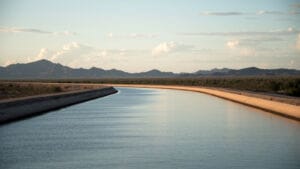Merriam-Webster’s 2022 word of the year was gaslighting — a form of deceit where someone is manipulated into questioning the validity of their own reasoning — but there was a well-known noun burning in the minds of many last year: inflation. Indeed, December’s Consumer Price Index (CPI) report showed that prices for all items rose 0.1% in November and were up 7.1% over the prior year. And inflation plays a big role in Arizona’s economic outlook for 2023.
“Core CPI, which excludes food and energy prices, increased 0.3% from September to October — a marked step down from the 0.6% reading the previous two months and the average 0.5% over the first nine months of [2022],” explains Christopher Waller, a member of the Board of Governors of the Federal Reserve, during Arizona State University’s (ASU) Economic Forecast Luncheon on Nov. 16, 2022.
READ ALSO: Here are the Ranking Arizona Top 10 lists for 2022
Even though the apparent slowing of inflation is welcome news, Waller cautions against thinking the U.S. is fully out of this economic briar patch. He notes that other monthly CPI reports since the onset of the pandemic have shown inflation rates dipping, only to rise again a few months later.
“We’ve seen this movie before, so it’s way too early to know if it’s going to have a different ending than what we saw [in 2021] and [summer 2022],” Waller continues. “Inflation remains too high relative to the [Federal Open Market Committee (FOMC)]’s target [of 2%].”
Interest rates
In other words, the Fed is unlikely to stop raising interest rates soon, but the intensity of the hikes may soften. On Dec. 14, interest rates rose by 50 basis points (bp), smaller than the four straight 75 bp increases throughout 2022.
Elevated borrowing costs help to cool inflation since it becomes more expensive for individuals to get a mortgage or businesses to take out loans to purchase new equipment. By reducing demand, higher interest rates solve the “too much money chasing too few goods” problem of inflation.
How high will rates go? That depends on economic conditions going forward, Waller says. He likens the Fed’s actions to a plane taking off. The pilot fires the engines to get the plane in the air as quickly as possible, adjusting the rate and angle of ascent along the way. Once cruising altitude is achieved, weather and turbulence may force the pilot higher or lower to keep the journey smooth.
“At a certain point, policy will reach an optimal cruising altitude,” Waller explains. “But we don’t know exactly what that level will be. Maybe new data will point to a shallower climb at a lower cruising altitude, which would suggest stepping down to 25 bp. Or it could be necessary to continue climbing a little longer to a higher final altitude by implementing a sequence of 50 basis point hikes. In the end, the higher we raise the policy rate, the more pressing it is to think about the terminal rate and how much policy should be adjusted to get there.”
Arizona’s economic outlook
At the ASU Economic Forecast Luncheon, Dennis Hoffman, professor of economics at ASU and director of the L. William Seidman Reasearch Institute, gave his economic analysis of Arizona and Metro Phoenix. He says 2022 was a strong year for the state — despite sputtering towards the end — with 3.8% employment growth and 112,400 jobs created.
Throughout the pandemic, Arizona embraced businesses and had a more open policy, which helped the state recover lost jobs much quicker than the rest of the country. By November 2021, Arizona regained all lost jobs due to the public health crisis whereas the U.S. didn’t reach that point until July 2022.
“Coming into the pandemic, we had higher unemployment rates than the nation on average, and now we’re lower,” Hoffman notes. “Fortunately, in [2022] both the state and U.S. have virtually record low unemployment rates.”
Looking at Arizona’s strongest industries, Hoffman points out healthcare, manufacturing, logistics and science and technology. “Many of us thought it was going to be tough to bring manufacturing back to Arizona,” he says. “I think it’s a testament to all of us in building a workforce and creating a welcoming business climate. Kudos to Sandra Watson and the [Arizona Commerce Authority] on that front.”
Looking forward, Hoffman expects significant deceleration in job growth, with a total of 24,500 new positions forecasted for 2023. He also expects strong population growth to continue, but not as quickly as it did pre-pandemic — though he hedges that there’s been issues with census data that make it difficult to estimate.
“Will we continue to attract young and innovative workers? Will concerns over climate, water, women’s rights, the border crisis — will they matter to them?” Hoffman asks.
Housing in 2023
Housing affordability will continue to be an issue for the Grand Canyon State. With higher interest rates, the purchasing power of a would-be homeowner diminishes greatly. For example, a $400,000 mortgage loan with a 3% rate means a monthly payment of $1,686. If that interest rate doubles to 6%, the payment balloons to $2,398, constituting an additional $8,544 each year.
Not only are interest rates making mortgages more expensive, but the level of residential permits — signifying new multifamily or single-family home construction — has also dipped.
“Housing is considerably less affordable here in Arizona than it was just five years ago,” Hoffman explains. “Just at a time when millennials really want to consume housing, it’s increasingly out of reach for them.”
Hoffman believes the Fed is on the right track but adds that overly tight monetary policy has harsh and lingering effects. In the event of a moderate to severe national recession, he believes the economic pain would extend through mid-2024. Job growth in the state and the Valley would essentially stagnate and be accompanied by major delays in construction and expansion plans, causing the manufacturing boom to slow.
“This is not our baseline; this is a pessimistic scenario of what things could look like,” he concludes. “We frankly have long-term economic advantages in this state. We have a competitive tax structure, affordable labor and relatively new infrastructure. Sustaining these advantages will be the challenge.”




